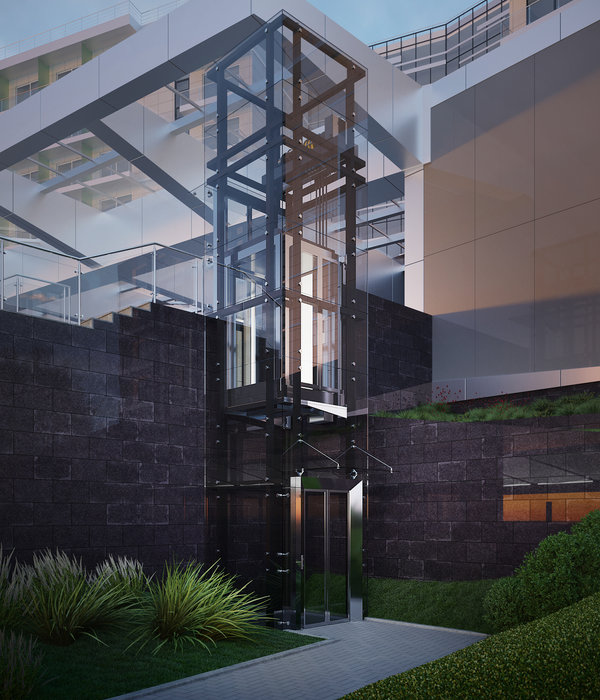Piyandeling社区位于万隆Mekarwangi村庄的偏远地区,是基于Guha Bambu和Alfa Omega学校建筑形式建造的庇护性空间,它结合传统细木工和竹胶细木工,实现了传统且更加工业化的建造方式。该项目由三部分组成:第一部分是名为“Sumarah”的私人住宅;第二部分是为当地未来教育平台设计的开放空间,名为“Kujang”;第三部分是未来牙科诊所和设计工作室,名为“Saderhana”。
Piyandeling is located in a remote area of Mekarwangi Village, Bandung. This project is a sanctuary space that exercises the design based on the tectonic grammar that was elaborated from Guha Bambu and Alfa Omega School, it forms an adaptation of traditional and more industrial approaches mixing traditional joineries and glued joinery of bamboo. Piyandeling consists of 3 components, the first one is a private family building named “Sumarah”, the second is a hall that is an open space designed for a future educational platform for kids in Mekarwangi village named “Kujang”. The third is a future dentist space, a design studio named “Saderhana”.
▼项目鸟瞰,aerial view © Eric Dinardi
▼近景鸟瞰,closer aerial view © Eric Dinardi
▼主立面,main facade © Eric Dinardi
Sumarah是一栋三层的家庭式住宅,由两间儿童房、一间主卧和共用浴室组成。建筑的外围护结构使用300×600mm的再生塑料板覆盖并保护内部的竹结构,并形成具有双层通风和双层隔热作用的走廊,通往核心生活空间。围护结构可以开启,由使用竹锁固定的竹结构支撑。核心生活空间是卧室,位于3×3m的柱网之中。
Sumarah is a three-storey house for 1 family consists of 2 kid bedrooms, 1 master bedroom, and shared bathrooms. The building envelope is constructed with recycled 300 x 600 mm plastic panels to cover and protect the inner bamboo structure forming a service corridor with double cross air ventilation and double wall insulations to the core living space of the building. The envelopes are openable, supported by a bamboo structure that can be locked with a traditional lock made of bamboo. The core living space is the bedrooms in the rectangular grid of 3 m.
▼外观,external view of Sumarah © Eric Dinardi
▼室外露台,terrace © Eric Dinardi
▼外围护结构由300×600mm的再生塑料板构成, envelope is constructed with recycled 300 x 600 mm plastic panels © Eric Dinardi
▼围护结构可以开启, envelopes are openable © Eric Dinardi
▼底部竹结构,bamboo structure © Eric Dinardi
建筑实现了三种主要材料的拼接,包括再生塑料、当地丛生竹以及由基地范围五公里内提供的地基石材。这种组合方式始于将竹艺融入矩形柱网空间的探索,天花、地面、柱子、门把手、锁具和装饰细部均为现场手工制作,为整体空间创造出工艺品。
The architecture is designed as an exercise of the bricolage concept using 3 types of main material such as recycled plastic, a local type of sympodia bamboo, and stone for the foundation which supplied within a 5 km radius. The composition started as an exploration on how can bamboo craftsmanship integrated with modular rectangular space to create such integrated craft carving bamboo composition from the ceiling, floor, column, door handle, lock, and finishing details handcrafted in site creating art and craft composition in the whole integrated space.
▼入口,entrance © Eric Dinardi
▼双层通风与隔热的走廊 © Eric Dinardi corridor with double cross air ventilation and double wall insulations
▼全竹空间,full bamboo space © Eric Dinardi
▼二层公共空间,common space on first floor © Eric Dinardi
▼二层卧室,bedrooms on first floor © Eric Dinardi
▼三层客厅,living room on second floor © Eric Dinardi
▼竹雕细部,details © Eric Dinardi
Kujang是一栋与有机农田相连的双层漂浮结构,其开敞的厅堂用于会议和集会活动。该部分采用4-5m柱网的竹结构,屋顶覆盖Nipah树叶和防水膜。
The second project, Kujang is a two-storey floating structure for an open-air hall for meetings and gatherings connecting with organic farms. It is constructed from the 4 – 5 m grids of bamboo structure and covered with Nipah leaf combined with a waterproofing membrane for the roof.
▼Kujang外观,external view of Kujang © Eric Dinardi
▼入口,entrance © Eric Dinardi
▼庭院,courtyard © Eric Dinardi
厅堂采用西爪哇省的Julang Ngapak乡土建筑形式,弯曲的竹栏杆呈现精细的双曲面形式,这种形式更加坚固和灵活,形似鸟类飞翔的轮廓或当地传统武器的运动轨迹。
Forming the Julang Ngapak as a traditional West Java vernacular building, the playful balustrade of bent bamboo is played as a more elaborated hyperboloid form, it is stronger, and more flexible and creates a silhouette of the natural movement of birds or movement of Kujang which is a traditional weapon in Sunda Tradition.
▼一层与有机农田相连,Kujang is connected to the organic farms on gound floor © Eric Dinardi
▼采用采用4-5m网格的竹结构,the 4 – 5 m grids of bamboo structure © Eric Dinardi
▼坡道,ramp © Eric Dinardi
▼开敞的厅堂,弯曲的竹栏杆呈现精细的双曲面形式,open-air hall,the playful balustrade of bent bamboo is played as a more elaborated hyperboloid form © Eric Dinardi
▼细部,details © Eric Dinardi
Saderhana由两座位于基地边缘的简易单层建筑组成,容纳了牙科诊所、设计工作室和地下祷告室。单层建筑以石材为基台,以竹子为屋顶,形成了覆盖防水膜和Nipah树叶的Talahap传统竹结构。祷告室由竹骨架和竹形混凝土挡土墙构成,创造出原始的、基本的、谦虚而朴实的饰面,并且具有一定经济性。
The third project, Saderhana is basically a simple 1 storey of two buildings on the perimeter as dentist space, and design studio, and the underground pray room. The 1 storey building constructed with stone as a platform and bamboo as a roof providing a “Talahap” traditional bamboo construction covered with layers of waterproofing membrane and Nipah. The praying room is constructed with bamboo skeletal and concrete which forms a retention wall and carved bamboo shape formworks. The idea is creating finishes that are raw, basic, humble, and honest in the expression and forming such economic sensitivity.
▼祷告室入口,entrance of pray room © Eric Dinardi
▼地下祷告室,竹骨架与混凝土墙,underground pray room,bamboo skeletal and concrete walls © Eric Dinardi
上述三部分组成了在Piyandeling地区运行的拼接材质建筑群。该项目可以理解为在一片土地上设计和建造,就需要抓住当地精神的本源。
The three projects forms a bricolage architecture that is exercised in Piyandeling. It is an understanding that to design and build something out of the land, the project needs to find the roots of Local Genius.
▼一层平面,ground floor plan © RAW Architecture
▼二层平面,first floor plan © RAW Architecture
▼三层平面,second floor plan © RAW Architecture
▼屋顶平面,roof plan © RAW Architecture
▼立面,elevations © RAW Architecture
▼剖面,sections © RAW Architecture
{{item.text_origin}}












